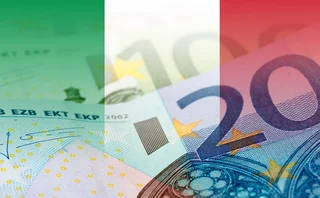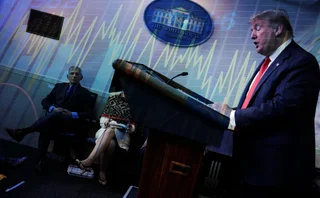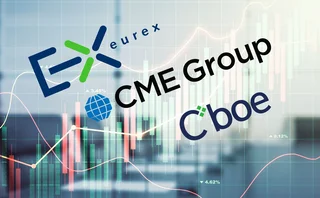
Rates rebound
Increased volatility in interest rate markets is a welcome development for structured product dealers and real-money accounts. But it's a different story for those involved in the offshore funding markets, where liquidity is close to all-time lows. By Rob Davies

Interest rate-linked product dealers started 2007 with little optimism, as interest rate yield curves around the world were flat or inverted and there was limited volatility in the market. But that all changed at mid-year, when interest rate volatility spiked sharply and credit structures fell out of favour, thus creating many opportunities to sell interest rate-linked products to Asia's cash-rich investors.
The movements in Deutsche Bank's DGX volatility index in the past six months demonstrate the large shifts in the market. The index, a weighted gamma average of three-month options on two-, five-, 10- and 30-year US interest rates, was under 60 basis points in mid-June but had risen to 110bp in September. Despite dropping to the low 90s basis-point level in early October, confidence in the wider financial markets had not been fully restored and by early December the index had rebounded to 110bp.
"To a certain extent, the recent volatility has carried into Asia," says Michael Parker, head of Asia-Pacific options trading for the global rates group at Deutsche Bank in Singapore. "Although rates are not quite as correlated to the US as they used to be, the dollar still has a leadership role for developed Asian markets. Consequently, we have seen volatility across Asian rates markets, particularly in South Korea. The third quarter was unusually busy for the rates group."
Investors have seen even sharper rises in volatility in other asset classes, such as credit, and deployed their money in interest rate products, viewing them as a relative "safe haven", Parker adds. "Lower-risk index trades are proving very popular, with the returns high for a given level of risk."
But the head of interest rates at a rival bank in Singapore says uncertainty about the global economy is putting significant pressure on rates at the front end of the curve, which is boosting dollar forward rate buyer trades. And the effect of market pressure on the US Federal Reserve Board to further cut the US Federal funds interest rate, which has fallen from 5.25% earlier this year to 4.25% has seen dollar weakening against the Japanese yen from 123 to the dollar in June to as low as 107.55 on November 23, its weakest level for two years.
"The yen has appreciated strongly since June, and this is giving strong impetus for FX hybrid trades," says the unnamed banker. "Volatility has helped steepen the front-end of the dollar curve, with forward rates rolling down the curve. As Libor has increased, so the curve has been inverted."
One- and three-month US dollar Libor is fixing high at the moment, but the market expects rate cuts over the next year, so the curve dips, before anticipating rises after two years. "Short-term rates on a forward basis have dropped, but after one or two years are expected to rise again," the banker says. "Consequently, dollar forward rate buyer trades have gone through the roof."
Opportunities for returns
For those nimble enough to exploit it, market dislocation is creating opportunities to make significant returns. In South Korea, for example, the implied interest rate on cross-currency swaps has fallen dramatically, allowing dealers to package this into rates products being sold to real money and short-term accounts.
"In South Korea, we are seeing a negative basis trade," says a managing director of interest rate and forex strategy at a Singapore-based hedge fund. "Rates at the front end of the curve have fallen sharply, which makes it a good time to borrow won and buy domestic-currency government bonds, effectively to get a Libor spread. You are effectively borrowing at zero to get Libor-plus-200-type returns." (See graph.) He estimates around $3 billion has already been traded on this arbitrage play.
The situation may partly be due to South Korean shipbuilders hedging future flows of dollars. There is a backlog of orders worth $100 billion, according to the Korean Shipbuilder's Association, that is driving rates down, because there is a shortage of available onshore dollars to hedge. As a result of the credit crunch, it is extremely difficult for South Korean borrowers to issue corporate bonds offshore. Hedge funds have also stepped in to conduct forward won/dollar trades with South Korean companies that are looking to hedge.
Besides opportunistic trades by real-money accounts and bank proprietary trading desks, there has also been an increase in longer-term, lower-risk alpha index and outperformance products. "Obviously there has been a shift away from credit products in recent months," says a Hong Kong-based options trader. "And equity markets are no longer seen as a one-way bet when you commonly see single-day moves of 3-4% on various indexes. That gives investors pause for thought and so, together with expected Fed cuts, you have good drivers for structured products."
With so much uncertainty around, bankers believe clients are also eager to look at thematic trades. Deutsche Bank, for example, in November launched its Asia Convergence Indices to tap into what it sees as growing correlation between Asian currencies in 12 markets and an informal monetary union emerging (see News, page 6).
Market turmoil may be leading to openings for structured product providers, but from a wholesale risk management and funding perspective, interest rates volatility is creating headaches for banks.
"Libor is the canary in the financial market goldmine, and those close to the money markets understand that the liquidity markets that grease the wheels of global markets are seizing up," says Sean Keane, head of Asia-Pacific interest rates trading at Credit Suisse in Singapore. "So it is little wonder that money-market traders are among the most bearish on growth."
Even as expectations for Fed rate cuts grow, banks continue to set Libor higher, adds Keane. "This signals an unwillingness to lend to each other, at the same time that they evidence an inability to raise funds themselves," he says.
And Keane warns that limited liquidity is providing an illusion that some asset classes, including three-month eurodollar and 10-year US Treasury notes, are less volatile. "Even in the asset classes that are trading, you get periods of lower volatility due to the liquidity situation," he says. "In what were previously deep and liquid markets, we are now seeing little or no price discovery on a given day."
Both the eurodollar and 10-year Treasury notes are usually quoted around the clock on very tight bid/offer margins and in large volumes. In recent weeks, spreads have doubled in many contracts for the equivalent volume, meaning that any reasonably large trade is difficult to hedge and is moving the market to a much greater extent than would normally be the case. Volatility has consequently spiked in all areas, says Keane.
Bankers say there are few buyers of cash assets such as corporate bonds and those that are buying intend to hold the assets until maturity. "However, the deterioration in certain asset classes has led to some forced sellers or forced mark-to-marketers to lighten their holdings," says Keane. "As the market is so short of cash and buyers, some trades are happening at 0.25-0.30 cents on the dollar."
The most obvious example of a market that has changed drastically since June is short-term US dollar interest rates. Normally deep and liquid, with a narrow bid/offer spread, it is now difficult to get prices for over-the-counter products. "Short-term interest rate traders will usually run a mismatch basis risk between swaps and products such as forward rate agreements and exchange-traded futures," says Keane. "In less volatile periods, it will put them all in the same portfolio, because there is a stable relationship between them. For example, the spread between overnight indexed swaps and FRAs (forward rate agreements) would usually be between three and six basis points. Now this has exploded to more than 100bp."
This means traders can no longer take this basis risk on their books due to the difficulty of hedging it. "So you are removing the traders from the picture, which leaves the real-money players," says Keane. "Liquidity is at its lowest level for several years."
Banks are pressing the Fed to make three consecutive rates cuts - the first of these took place on December 11, with a 25bp reduction in the Federal funds rate. However, Keane says it is unwise to expect this measure to make all volatility go away and have the pre-June order restored early in 2008.
Accessing term funding
"Our view is that despite the Fed cuts, there is still a major problem in accessing term funding," adds Keane. "Banks need to borrow in the three-, six- and nine-month interest rates markets to meet internal and regulatory guidelines. They will also want some portion of funding going out to 10 years." He adds that banks do not want these markets to dry up, because that will increase reliance on overnight borrowing. "However, term funding is drying up, which puts significant pressures on banks and financial systems in developed markets," says Keane.
For instance, it was only the intervention of the Reserve Bank of Australia that saw a major bank liquidity crisis averted in the country, says a Sydney-based interest rates trader at a European bank.
Australia is one of the Asia-Pacific markets where domestic banks could meet funding problems similar to those faced by banks in Europe and the US. That's because its banks are very dependent on offshore funding, which is then swapped back into Australian dollars.
"Fortunately the Reserve Bank sensed early on that Australian banks were facing similar pressures to those seen in the US, with liquidity profiles decaying rapidly," says the Sydney-based trader. "Consequently, the (central) bank extended the terms of repos out to 180 days to offset concerns about bank exposures through structured investment vehicles. It also widened the collateral in repo markets to include residential mortgage-backed and asset-backed securities as well as asset-backed commercial paper."
The move increases the range of assets the Reserve Bank of Australia can buy, enabling it to pump more money into the financial system to ease pressure on domestic banks to raise interest rates. It also was designed to restore investor confidence in the country's banks, which as a result of the credit crunch were finding it difficult to raise money in the short-term - 30-, 60- and 90-day - commercial paper markets. The effect of its intervention at the height of the turmoil in September was to immediately cut the three-month bank-bill rate to 6.90% from 7.00%.
Only users who have a paid subscription or are part of a corporate subscription are able to print or copy content.
To access these options, along with all other subscription benefits, please contact info@risk.net or view our subscription options here: http://subscriptions.risk.net/subscribe
You are currently unable to print this content. Please contact info@risk.net to find out more.
You are currently unable to copy this content. Please contact info@risk.net to find out more.
Copyright Infopro Digital Limited. All rights reserved.
As outlined in our terms and conditions, https://www.infopro-digital.com/terms-and-conditions/subscriptions/ (point 2.4), printing is limited to a single copy.
If you would like to purchase additional rights please email info@risk.net
Copyright Infopro Digital Limited. All rights reserved.
You may share this content using our article tools. As outlined in our terms and conditions, https://www.infopro-digital.com/terms-and-conditions/subscriptions/ (clause 2.4), an Authorised User may only make one copy of the materials for their own personal use. You must also comply with the restrictions in clause 2.5.
If you would like to purchase additional rights please email info@risk.net
More on Markets
Ice’s AFX swoop shines spotlight on Ameribor prospects
CEO John Shay steps down after exchange group buys firm for mortgage and index synergies
Franklin Templeton dethrones MSIM as top FX options user
Counterparty Radar: MSIM continued to cut RMB positions in Q3, while Franklin Templeton increased G10 trades
Lenders scramble to get ahead of Italian fallback mandate
New law requiring robust fallbacks for Euribor will take effect on January 10
FX automation key to post-T+1 success, say custodians
Custody banks saw uptick in demand for automated FX execution to tackle T+1 challenges
Review of 2024: as markets took a breather, firms switched focus
In the absence of major crises and rules deadlines, financial firms revamped strategy, services and practices
Cboe plans Q2 dispersion futures listing
Expectations of post-US-election uncertainty drives launch, and could help bank equity desks hedge OTC risks
Futures exchanges look to ride credit ETF wave
Proponents hope for increased buy-side trading, with three exchanges competing for market share
Doubts raised over new FX platform disclosures
New disclosure sheet template will require platforms to outline how they charge for data







